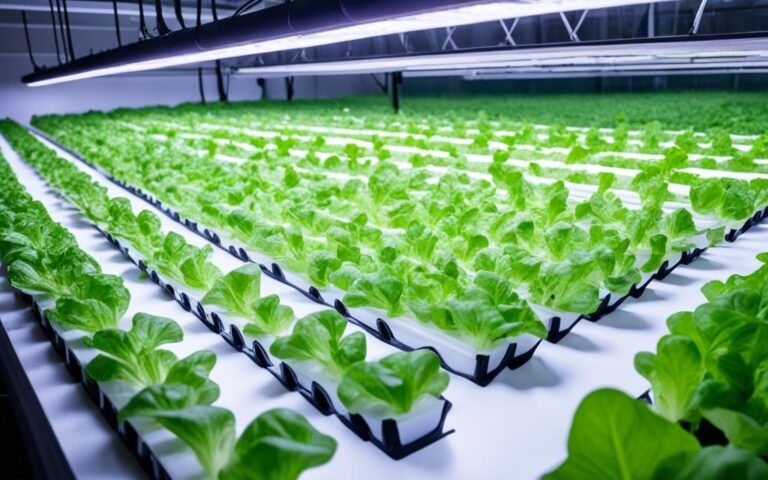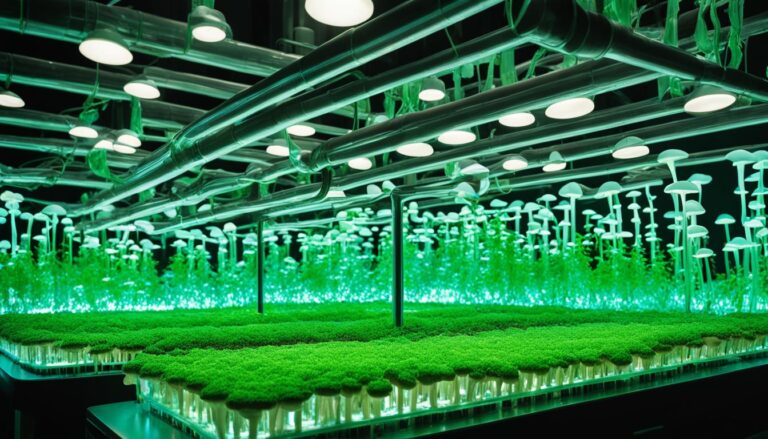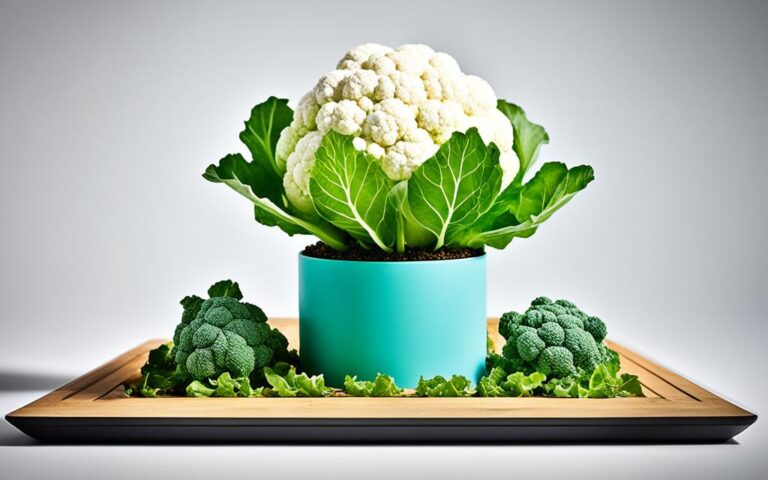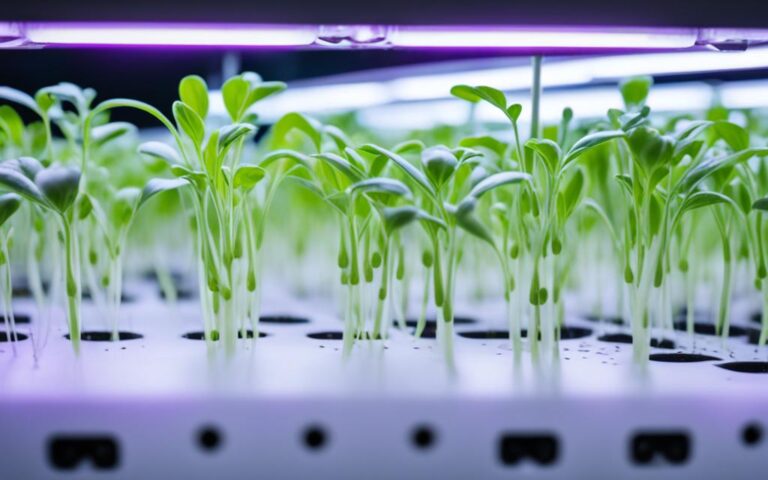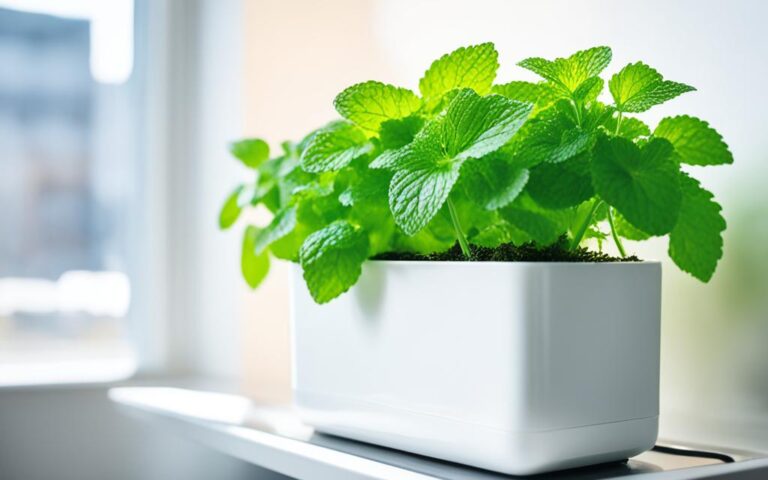Grow Flavorful Hydroponic Basil at Home
Basil is a favorite among both traditional and hydroponic growers. Its fragrant leaves and many uses in cooking make it great for indoor gardens and urban farms. Whether you’re experienced or just starting, growing basil hydroponically is rewarding and tasty.
With the right conditions and care, you can grow a lot of tasty hydroponic basil at home. This guide will help you pick the best basil types and set up a hydroponic system. It covers everything you need to know to grow basil hydroponically and make the most of its flavor and smell.
Key Takeaways
- Basil is a popular and versatile herb that thrives in hydroponic systems.
- Different basil varieties exhibit unique characteristics like growth rate, disease resistance, yield, and flavor.
- Hydroponic basil requires specific light, temperature, and nutrient conditions for optimal growth.
- Proper setup, maintenance, and harvesting techniques are crucial for a successful hydroponic basil crop.
- Hydroponic basil can be a rewarding and flavorful addition to any indoor gardening setup.
Table of Contents
Introduction to Hydroponic Basil Cultivation
Hydroponic basil cultivation has many benefits over traditional soil methods. It allows for growing basil all year, controlling conditions better, and getting more yield in less space. Basil does well in different hydroponic systems, each with its own perks.
Benefits of Growing Basil Hydroponically
One big plus of hydroponic basil is it can produce up to three times more than soil-grown basil. These gardens use less water and fertilizer than soil gardens. Plus, hydroponic basil might lower cancer risk and fight off bacteria and fungi.
Overview of Hydroponic Systems for Basil
Growers have many hydroponic systems for basil to pick from. The Ebb and Flow, Nutrient Film Technique (NFT), and Deep Water Culture (DWC) are great for basil. It’s important to choose a system that makes it easy to prune and harvest often, as basil needs regular care.
| Hydroponic System | Description |
|---|---|
| Ebb and Flow | This system floods the plants with nutrient solution and then drains it, letting the roots get oxygen and nutrients. |
| Nutrient Film Technique (NFT) | The NFT uses a shallow flow of nutrient-rich water over the roots, giving plants constant water and nutrients. |
| Deep Water Culture (DWC) | DWC dips the roots in a nutrient-rich solution, with an air pump and stone for root oxygen. |
Knowing the perks of hydroponic basil and the systems available helps gardeners choose the best way for their needs. This way, they can enjoy a bountiful basil harvest all year.
Selecting the Right Basil Varieties
Choosing the right basil for hydroponics is key. Not all basil types are equal. Some are better for their growth rate, disease resistance, and flavor. Knowing the unique traits of different basil varieties helps pick the best for your hydroponic setup.
Popular Basil Types and Varieties
There are two main types of green basil: Genovese and Italian Large Leaf. Genovese is famous for its classic pesto taste and its leaves are shaped like spoons. Italian Large Leaf is great for its high yield and big, pointed leaves.
There are many other basil varieties to explore, like Red/Purple, Citrus, Asian/Thai, and Lettuce Leaf. Each has its own special traits.
Factors to Consider When Choosing Varieties
- Growth Rate: Some basil grows faster, giving you quicker harvests in hydroponics.
- Disease Resistance: Some like Prospera Red DMR and Nufar are more resistant to diseases like Fusarium and downy mildew.
- Plant Habit: Compact types like Prospera Compact work well in containers and hydroponics. Larger varieties need more space.
- Leaf Type: Basil leaves come in different shapes and sizes, making some better for pesto or salads.
- Yield and Flavor: Varieties like Everleaf and Genovese give lots of harvests. Some have unique flavors.
Think about these factors to pick basil that fits your hydroponic setup and tastes. This way, you’ll get a great harvest that tastes amazing.
| Basil Variety | Characteristics | Suitability for Hydroponics |
|---|---|---|
| Genovese | Classic pesto flavor, heavily cupped, spoon-shaped leaves | Highly suitable |
| Italian Large Leaf | High productivity, larger, pointed, rugose leaves | Highly suitable |
| Prospera Red DMR | Disease-resistant, compact, attractive plants | Highly suitable |
| Everleaf | Very slow to bolt, medium-large leaves | Suitable |
| Prospera Compact | Resistance against downy mildew and Fusarium, compact habit | Highly suitable |
Setting Up Your Hydroponic Basil System
Setting up a hydroponic basil system is rewarding and practical. It lets you grow fresh, flavorful basil at home. Choose a system that makes it easy to prune and harvest the plants. This encourages them to grow more and increases your yield.
Proper spacing is key, with 9-12 inches between plants. This allows for good air flow and helps the plants spread out.
The Deep Water Culture (DWC) method is a popular choice for basil. It uses a 2-gallon bucket as the water reservoir. The bucket has a 5-inch pot outline with 12 holes on each side and a quad air stone setup.
You’ll also need 3/4-inch PVC pipes, 90-degree outlets, and Thread to PVC adapters. These parts are easy to find and assemble with a miter box.
Building the top frame requires weatherproof sockets, tees, and more PVC lengths. The lighting setup can be tricky, but planning well ensures even light for your basil.
Before setting up, sanitize all parts with a diluted bleach solution to avoid mold. Keeping the water’s pH between 5.0-6.0 is vital for your basil’s health and nutrient absorption.
- Choose a hydroponic system that allows easy access for pruning and harvesting, such as a Deep Water Culture (DWC) setup.
- Ensure proper spacing between plants, around 9-12 inches, to promote air flow and growth.
- Construct the top frame using weatherproof sockets, tees, and PVC pipes.
- Carefully sanitize all components with a diluted bleach solution before assembly.
- Adjust the water pH to the recommended range of 5.0-6.0 for optimal basil growth.
With the right setup and attention to detail, you can create a thriving hydroponic basil system. This will give you a steady supply of fresh, flavorful leaves for your cooking. By following these guidelines, you’re on your way to growing your own hydroponic basil at home.
Nutrient and Water Requirements
Growing tasty hydroponic basil needs a fine balance of nutrients and the right water. Basil does well in a solution full of nutrients. These nutrients help it grow strong and taste great.
Essential Nutrients for Basil
Hydroponic basil needs a few key nutrients, mainly during its growing stage. A mix like Dyna Gro Foliage Pro, rich in nitrogen, helps it grow big and green. Adding magnesium and calcium with Cal-Mag also boosts its health.
Maintaining Optimal pH and EC Levels
The best pH for growing hydroponic basil is between 5.5 and 6.5. This makes sure the nutrients it needs are easily available. Keeping the electrical conductivity (EC) between 1.0 and 1.6 mS/cm is also key. This ensures the right amount of nutrients in the solution. The EC level might change with the season and basil’s growth.
| Parameter | Ideal Range |
|---|---|
| pH | 5.5 – 6.5 |
| EC (Electrical Conductivity) | 1.0 – 1.6 mS/cm |
By watching and adjusting the nutrient solution’s pH and EC, growers can make sure their hydroponic basil gets the best nutrients. Keeping these levels right is key for strong growth and great taste. It’s essential for a successful hydroponic basil garden.

Lighting and Temperature Needs
To grow healthy hydroponic basil, you need the right light and temperature. Basil loves bright light and needs at least 12 mol/m² of it for best growth. This ensures it grows well and produces a lot.
For basil, give it 14-16 hours of light each day. Use T5 fluorescent lights or energy-saving LED grow lights. These lights give the right spectrum and intensity for basil to grow strong.
Optimal Light Conditions for Basil Growth
- Minimum light requirement: 12 mol/m² per day
- Recommended light duration: 14-16 hours per day
- Suitable lighting options: T5 fluorescent, LED grow lights
Right temperature is also key for growing hydroponic basil. Basil does best in a warm spot, between 65-80°F (18-27°C). The sweet spot for growth is 75-85°F (24-29°C).
| Parameter | Optimal Range |
|---|---|
| Temperature | 65-80°F (18-27°C) |
| Humidity | 40-60% |
| pH | 5.6-6.6 |
| EC (Electrical Conductivity) | 1.6-2.2 mS/cm |
With the right light and temperature, you can make a perfect space for your hydroponic basil. This way, your basil will grow well and give you lots of tasty leaves.
Planting and Germination Process
Growing hydroponic basil can start from seeds or transplants. Each method has its own benefits and things to consider. Let’s look at both ways.
Starting from Seeds
Germinating basil seeds is easy and fun. Keep the temperature at 75°F (24°C) and use special seed starting media. Seeds germinate in 72 hours, leading to strong seedlings in weeks.
Starting with seeds lets you pick from many types, like the big Genovese basil. These plants can grow leaves up to 6 inches long. You get to choose the traits of your basil plants this way.
Using Transplants
You can also buy basil plants and put them in your hydroponic system. This saves time at the start. But, let the plants adjust and grow their roots for a few weeks before they’re ready for full production.
Cloning is another way to get basil plants. Take cuttings from a plant and root them in a hydroponic cloner. This method makes new plants just like the original. It takes 5 to 10 days for the cuttings to grow roots, then they’re ready for your system.
Whether you start with seeds or transplants, make sure your basil has the right conditions. This means the perfect temperature, humidity, and light for a great harvest.

Caring for Your Hydroponic Basil
Keeping your hydroponic basil healthy means you need to prune and harvest it regularly. Pruning helps the plants grow wider and gives you more leaves. You can pick leaves as you need them or take the whole plant. Always make sure to leave some leaves so the plant can keep growing.
Pruning and Harvesting Techniques
It’s key to prune and harvest your hydroponic basil the right way for its health and growth.
- Prune the tops of the plants often to make them grow wider and produce more leaves.
- You can pick leaves when you need them, or take the whole plant by cutting off the leaves. But always leave some leaves for the plant to keep growing.
- Don’t cut more than one-third of the plant’s leaves at once to keep it from getting stressed.
- Take out any yellow, wilted, or damaged leaves to keep your plant healthy.
- Make sure to store your harvested basil properly because it spoils quickly if it gets too cold.
By using these pruning and harvesting tips, you can make your hydroponic basil grow better and last longer.
“Proper pruning and harvesting are the keys to a bountiful hydroponic basil crop. Regular maintenance is crucial for keeping your plants thriving.” – Gardening Enthusiast
Keeping your hydroponic basil healthy also means looking after its environment. You need to control the temperature, humidity, and air flow. This helps prevent diseases like Botrytis cinerea, a fungus that can harm basil. By taking good care of your basil, you’ll always have fresh, tasty leaves for cooking.
Troubleshooting Common Issues
Growing hydroponic basil has its challenges. Pests, diseases, and nutrient issues are common. Knowing these problems and how to fix them ensures a healthy hydroponic basil crop.
Identifying and Addressing Pests and Diseases
Downy mildew and Fusarium wilt are big problems for hydroponic basil. Choosing disease-resistant varieties helps. But, it’s also key to watch your plants closely and act fast if you see infection signs.
Keeping the right temperature, humidity, and air flow stops these diseases from spreading.
Nutrient Deficiencies and Solutions
Hydroponic basil can lack nutrients, showing up as yellow leaves, slow growth, and curled leaves. Checking the nutrient solution’s pH and EC levels is vital. This ensures the plants get the right amount of nitrogen, phosphorus, and potassium.
Doing regular tissue analysis helps spot nutrient imbalances. Then, you can fix the fertilizer to help the plants recover and grow better.
“Proactively monitoring growing media and nutrient runoff is recommended to prevent economic losses due to nutritional disorders.”
Common nutrient shortages in hydroponic basil include nitrogen, phosphorus, potassium, calcium, magnesium, sulfur, iron, and boron. Changing the fertilizer mix often fixes these problems. It helps plants grow better and produce more.

Hydroponic Basil and Companion Planting
Gardeners can use companion planting to make their hydroponic basil grow better. They pick plants that need the same nutrients and like the same environment. These plants also help basil grow well.
Some great plants to grow with hydroponic basil are:
- Lettuce: Basil and lettuce need the same pH and nutrients, so they work well together.
- Lemon Balm: This herb makes basil taste better and keeps pests away.
- Parsley: Parsley and basil like the same conditions and keep pests away from each other.
- Peas: Peas fix nitrogen in the soil, which helps basil grow.
When picking plants to grow with basil, think about their water, nutrient, and light needs. Also, consider how they might affect each other in terms of pests and diseases. Choosing the right plants helps create a balanced and successful hydroponic system.
| Companion Plant | Compatibility with Hydroponic Basil |
|---|---|
| Lettuce | Shares similar pH and nutrient requirements |
| Lemon Balm | Enhances basil flavor and helps repel pests |
| Parsley | Thrives in similar growing conditions and deters pests |
| Peas | Nitrogen-fixing properties benefit basil plants |
By choosing the right plants and keeping conditions perfect, hydroponic basil growers can make a system that benefits from companion planting.
“Companion planting can enhance the overall health and productivity of a hydroponic basil system, creating a synergistic relationship between plants.”
Maximizing Yield and Flavor
To get the best growth and taste from hydroponic basil, focus on the right environment, nutrients, and how you harvest. With the right strategies, you can grow basil that tastes great and yields well.
Tips for Optimal Growth and Taste
Light is key for basil’s flavor. Studies show that more UV-B light makes basil taste better by increasing oils and aromas. Keeping the temperature right, between 15-25°C, also helps make basil more flavorful.
Getting the nutrients right is also vital. Basil needs enough nitrogen, phosphorus, and potassium to taste good. Using things like salicylic acid and jasmonic acid can boost the oils and quality of basil.
Harvesting at the right time is important. Basil picked when it’s young, under 12 cm tall, tastes better. Keeping the harvested basil at 10-12°C helps keep its smell and taste.
- Provide adequate UV-B light exposure to enhance essential oil production and flavor intensity
- Maintain optimal daytime temperatures between 15-25°C to encourage flavorful compound synthesis
- Ensure sufficient levels of key nutrients (nitrogen, phosphorus, potassium) to support flavor development
- Utilize biostimulants like salicylic acid and jasmonic acid to boost essential oil content and quality
- Harvest basil plants when young, under 12 cm in height, for the best flavor profile
- Store harvested basil at a consistent 10-12°C to preserve aroma and taste
Follow these tips for better growth and taste, and you’ll get more and better hydroponic basil. This will make your cooking amazing.
Remember, different basil types have different tastes. Picking the right type is key for the best flavor in your hydroponic setup.
“Increasing CO2 concentrations during basil production has been shown to increase fresh mass, while higher daily light integral and CO2 levels can also enhance the volatile organic compound content.”
| Environmental Factor | Optimal Range for Basil Flavor |
|---|---|
| Light Intensity | 600 μmol·m‒2·s‒1 or higher |
| Temperature | 15-25°C |
| Nutrient Levels | Sufficient N, P, K |
| Biostimulants | Salicylic acid, Jasmonic acid |
| Harvesting Stage | Less than 12 cm in height |
| Post-Harvest Storage | 10-12°C |
By tweaking these factors and practices, hydroponic basil growers can get the best yield and flavor. This gives consumers a top-notch culinary experience.
Harvesting and Preserving Your Basil
Growing hydroponic basil at home is rewarding. But, harvesting and preserving it is the real challenge. With the right methods, your basil can stay fresh and fragrant for months.
Harvesting Hydroponic Basil
Harvest hydroponic basil by cutting off the leaves as needed. Cutting the tops of the plants encourages more growth. If you’re taking the whole plant, remove the leaves and dry them. Storing fresh basil below 55°F can make it rot quickly.
Preserving Hydroponic Basil
Dried basil can keep its flavor and smell for several months. To dry it, hang the leaves upside down in a warm, airy spot or spread them on a baking sheet. Once dry, put them in an airtight container away from sunlight.
Freezing is another way to preserve basil. Blend the leaves with a bit of olive oil and freeze in ice cube trays. Or, freeze leaves one by one on a baking sheet and then in a freezer bag.
Quick action is key to keeping your hydroponic basil’s flavor and nutrition. By following these steps, you can enjoy your home-grown basil all year.
Conclusion
Growing hydroponic basil at home is both rewarding and easy. By knowing what basil needs for nutrients, light, and environment, you can have fresh herbs all year. With some care, hydroponic basil does well in many indoor setups, making it a great choice for gardeners.
Choosing the right basil type, using the best hydroponic system, and the right nutrients matter a lot. Today, hydroponic crops are worth USD 9.5 billion, showing how popular and promising this method is. By trying different basil types and perfecting your growing conditions, you can make your hydroponic basil taste amazing.
It doesn’t matter if you’re new to gardening or have been doing it for years. Growing your own hydroponic basil brings unmatched joy. This article’s tips will help you create a garden that makes your cooking better. You’ll always have this key herb ready for your meals.

